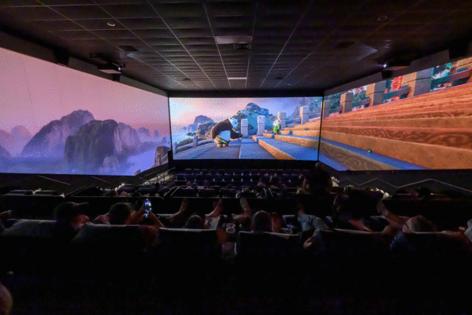ScreenX, which extends screen onto theater walls, is more movie for more money
Published in Entertainment News
DETROIT — In ScreenX, everything is bigger. Or at least considerably wider.
For the movie business, it's not necessarily a game changer as much as it's a game enhancer. It's a little bit extra, like whipped cream capping a latte, or a cherry on top of a gooey ice cream sundae.
ScreenX is a premium theatrical format that extends movie screens to the theater's walls to create an immersive, 270-degree viewing experience. That means the movie is wrapping around you, filling your peripheral vision, rather than simply unfolding on the screen in front of you — you know, the way movies have been for the last 100-plus years.
ScreenX, which bills itself as "cinema without limits," is not for every movie. It's not presenting a wider view of the papal voting sessions in "Conclave" or delivering even more of that static single room shot in "Here."
But for the action blockbusters or animated films for which it's activated, ScreenX plops viewers further into the world of the movie, and deeper into the vision of the filmmaker.
Locally, ScreenX debuted over the summer at MJR's Waterford location, and it arrived at MJR's Marketplace Cinema 20 in Sterling Heights last week, just in time for the dual blockbusters to-be "Wicked" and "Gladiator II."
At ScreenX presentations, the technology isn't activated for the entire length of the film. At a recent ScreenX showing of the animated adventure "The Wild Robot" at MJR Waterford, the three screens were on for about 62 of the film's 102 minutes, or about 60% of the film's runtime. This is typical.
Pre-show trailers aren't in ScreenX, and the theater bumper with the MJR theme song (the singalong one, with the trademark three claps) isn't either. Select scenes in the film are fully rendered for the three screens, and in the case of "The Wild Robot," the entire first 15 minutes of the movie were ScreenX-equipped.
But isn't the whole multiple screens thing distracting? It's not. A worst-case scenario would present two characters talking on screen from the left and right walls of the theater, with theatergoers' heads craning from side to side like they were watching a tennis match (or "Challengers").
ScreenX is mostly built to extend the action of whatever is on the main screen, with the two walls adding to what's in the edges of the frame. The main action is still in the middle, the sides are just filling viewers' vision with, well, more.
More is the name of the game for "Wicked" and for "Gladiator II" — more green scenery in the case of "Wicked," and more, er, sand in the case of "Gladiator II."
The further back you sit in the theater, the more you're able to appreciate the experience. The closer you get to the screen, the more the action surrounds, and eventually encapsulates, your full range of vision.
ScreenX, which has been around for more than a decade, was developed by CJ 4DPLEX, a subsidiary of South Korean multiplex chain CJ CGV. It's used on nearly 400 screens in 43 countries.
It comes at a time when premium large format, or PLF, offerings have been a bright spot for the theatergoing industry. Other examples of PLF include IMAX and 4DX, the latter of which presents a full sensory experience, including misting viewers if the movie calls for it, and hasn't yet made its way to Michigan.
ScreenX comes at an upcharge: in Waterford, it's $17 for an evening ticket, about $5 more than a regular showing.
It won't make a bad movie good, and being fully surrounded by something as aggressive as "Venom: The Last Dance" sounds like a cruel punishment. But for something enjoyable, it makes it a little bit sweeter, one step closer to living inside the world of the movie.
©2024 The Detroit News. Visit detroitnews.com. Distributed by Tribune Content Agency, LLC.













Comments